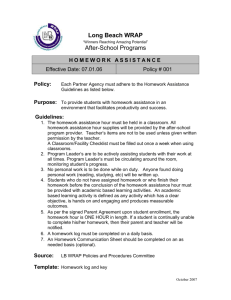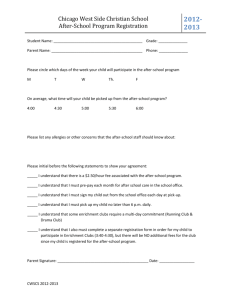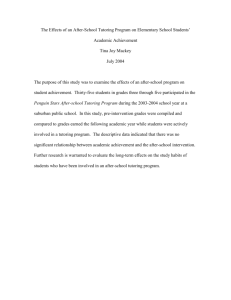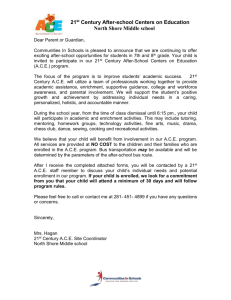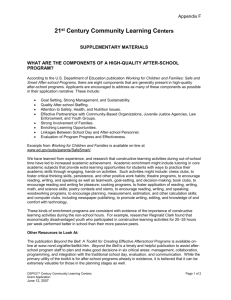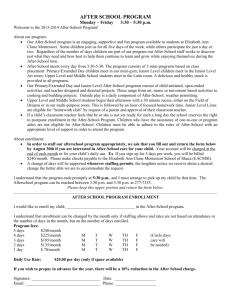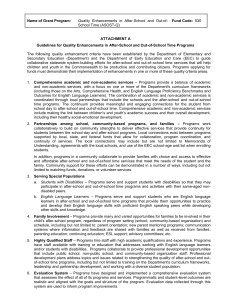lesson planning template
advertisement
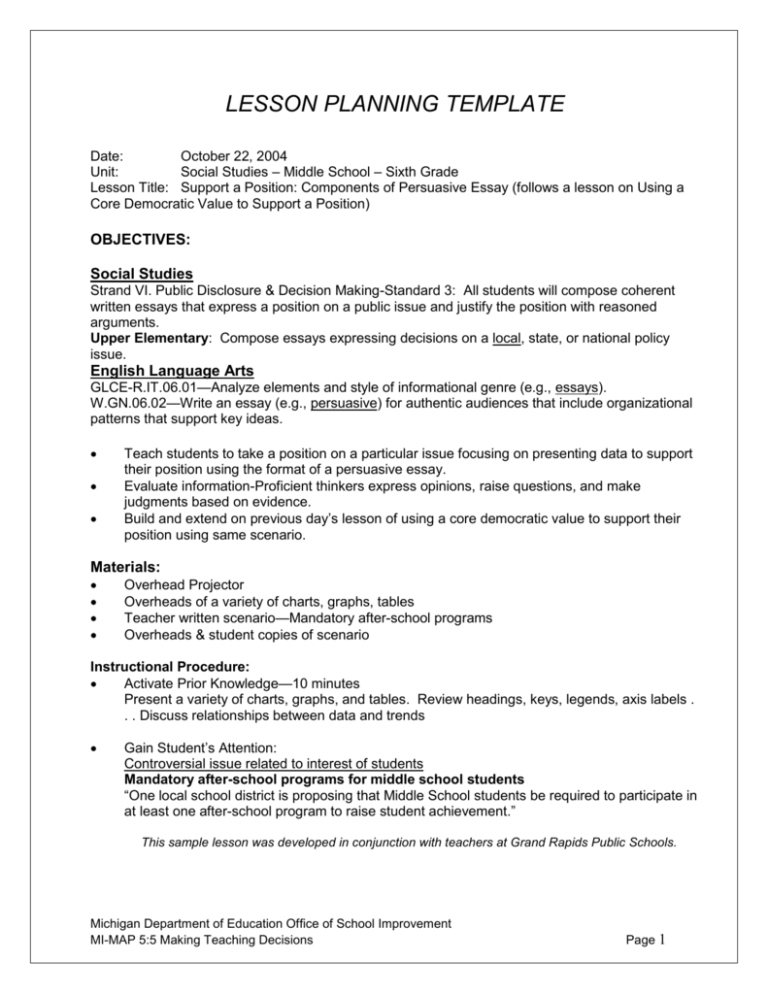
LESSON PLANNING TEMPLATE Date: October 22, 2004 Unit: Social Studies – Middle School – Sixth Grade Lesson Title: Support a Position: Components of Persuasive Essay (follows a lesson on Using a Core Democratic Value to Support a Position) OBJECTIVES: Social Studies Strand VI. Public Disclosure & Decision Making-Standard 3: All students will compose coherent written essays that express a position on a public issue and justify the position with reasoned arguments. Upper Elementary: Compose essays expressing decisions on a local, state, or national policy issue. English Language Arts GLCE-R.IT.06.01—Analyze elements and style of informational genre (e.g., essays). W.GN.06.02—Write an essay (e.g., persuasive) for authentic audiences that include organizational patterns that support key ideas. Teach students to take a position on a particular issue focusing on presenting data to support their position using the format of a persuasive essay. Evaluate information-Proficient thinkers express opinions, raise questions, and make judgments based on evidence. Build and extend on previous day’s lesson of using a core democratic value to support their position using same scenario. Materials: Overhead Projector Overheads of a variety of charts, graphs, tables Teacher written scenario—Mandatory after-school programs Overheads & student copies of scenario Instructional Procedure: Activate Prior Knowledge—10 minutes Present a variety of charts, graphs, and tables. Review headings, keys, legends, axis labels . . . Discuss relationships between data and trends Gain Student’s Attention: Controversial issue related to interest of students Mandatory after-school programs for middle school students “One local school district is proposing that Middle School students be required to participate in at least one after-school program to raise student achievement.” This sample lesson was developed in conjunction with teachers at Grand Rapids Public Schools. Michigan Department of Education Office of School Improvement MI-MAP 5:5 Making Teaching Decisions Page 1 INSERT B (cont.) Stimulus (Offer New Information): Scenario – Tell students that they will be receiving data from a public opinion survey that was conducted by a parent advocacy council that asked parents, students, and teacher groups, “Should middle school students be required to participate in an after-school program to raise student achievement and decrease student discipline issues?” Guided Practice (Model, Coach) Part A of Data Section: Before revealing data to students: 1. Have the students individually record one question a proficient thinker would have asked the person that surveyed them, assuming the role of a parent, a student, and a teacher. (three questions) 2. Have the student predict whether the three groups surveyed were for or against the new policy. 3. Reveal data for this section only and discuss data and student questions. Part B of Data Section: Before revealing data to students: 1. Ask each student to predict and record one other piece of data that would be important for the parent advocacy council to collect and present data on before a proficient thinking could take a position on the issue. 2. Reveal data for this section and facilitate a discussion. 3. Have the students generate statements or questions that are not answered by the data. Learner Performance (Instructor steps back) In small groups of four, present student with handouts of scenario with data compiled by a parent advocacy council. Assign Task: Report out to Class Have the students generate statements that are supported by data. Have students generate questions that are not answered by the data. Feedback Classify the group’s work into statements: Agree and Disagree. Assessment: Write a letter to a parent, teacher, or fellow student persuading them to agree or disagree in the event that they are interviewed. Each letter must: be in proper format; include data to support the position; and include a Core Democratic Value to support their position. Extension: (Generalized, Apply elsewhere, Reflect) Identify current policies within the school that students agree or disagree with or would like to see revised. Have them identify possible data sources and Core Democratic Values that they could use to support their position. PROFICIENT THINKERS: Adapted from the following resources: NWRL Strategies That Work, Harvey & Goudis Michigan Department of Education Office of School Improvement MI-MAP 5:5 Making Teaching Decisions Page 2 INSERT B (cont.) Mandatory After-School Programs for Middle School Students PART A One local school district is proposing that its middle school students be required to participate in at least one after-school program. Read the information below about this issue. A public opinion survey was conducted that asked the following groups, “Should middle school students be required to participate in an after-school program.” DATA SECTION Students 25% 75% … Agree with mandatory after-school program. … Disagree with mandatory after-school program. Michigan Department of Education Office of School Improvement MI-MAP 5:5 Making Teaching Decisions Page 3 INSERT B (cont.) Parents 40% 60% Teachers 50% 50% … Agree with mandatory after-school program. … Disagree with mandatory after-school program. PART B The parent advocacy council compiled the following data: Three out of five voters are willing to increase their taxes to pay for after-school programs. On school days between 3:00-6:00 p.m., the occurrence of juvenile violent crimes triples. Michigan Department of Education Office of School Improvement MI-MAP 5:5 Making Teaching Decisions Page 4 INSERT B (cont.) Of the students who spend no time in out-of-school activities: 49% are more likely to use drugs; and 39% are more likely to become teen parents. One middle school has had their mandatory after-school policy in place for three years. The following information has been compiled for its students. Average GPA Percentage of missing homework assignments Percentage of retentions Number of arrests for juvenile delinquency during the school year Year 1 2.2 25% 10% Year 2 2.8 18% 5% Year 3 2.6 9% 2% 50 20 10 TASK I Which of the following statements best describes the relationship between the percentage of missing homework assignments and the number of years in the mandatory after-school program? A. As the number of years in the program increase, the percentage of missing assignments decreases. B. As the number of years in the program increased, the percentage of missing assignments increases. C. As the number of years in the program increases, the percentage of missing homework assignments decreases by at least 10% each year. D. The number of years in the program has no effect on the percentage of missing homework assignments. TASK II Should the Middle School’s programs begin a mandatory after-school program? Write a letter to your superintendent expressing your opinions. Michigan Department of Education Office of School Improvement MI-MAP 5:5 Making Teaching Decisions Page 5
